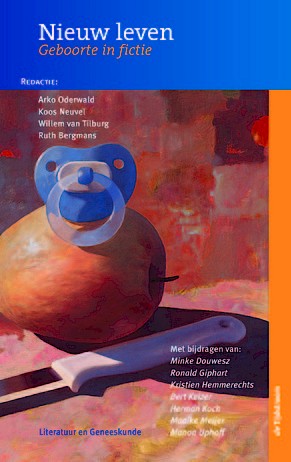Nieuw leven
Geboorte in fictie
—
Arko Oderwald, Koos Neuvel, Willem van Tilburg, and Ruth Bergmans (eds.), Nieuw Leven: Geboorte in Fictie [New Life: Birth in Fiction]. Utrecht: De Tijdstroom, 2012. Paperback, 465 pp., €25. ISBN: 978-90-5898-219-3.
Nieuw Leven: Geboorte in Fictie – a recent addition to the ambitious series Literatuur en Geneeskunde (Literature and Medicine) – seeks to link literature, film, and poetry to the medically and metaphysically interesting subject of birth. The compilation comprises thirty-six reflective essays, mostly about novels, but some about poetry or films; twelve excerpts from original prose; nineteen poems; and one graphic novel. These contributions each deal with birth and new life. Some deal directly with actual pregnancy and birth, while others use birth as a metaphor, for example in ‘the birth of a father’, a ‘second birth’ as a social being, and even the ‘birth of a poem’.
The first section ‘Before the Birth’, is about pregnancy but also about influencing creation itself. Themes include the artificial creation of human life in the Frankenstein and golem myths, and the brave new world of in vitro fertilisation and cloning. The birth metaphor in literature and art is explored in works of Proust and Frederik van Eeden, and in Russian futurism. An intermezzo of poems portrays pregnancy as a ‘passive existence’, a ‘safe haven’, and the ‘final agreement of generations’. This first section concludes with musings on the absence of new life, including essays on childlessness and adoption, failed attempts at in vitro fertilisation, and abortion.
The second section, ‘Birth’, focuses on birth itself. The stories portray birth as an arduous and dangerous undertaking often with complications needing immediate medical (technical) attention. Newborn babies are ‘crumpled, bloodied and grieving’, mourning the loss of the sanctuary of the womb. Gerard Reve goes so far as to state that it is ‘a great misfortune to be born’. Birth is also represented here as continuity, poetically reminding us that with the birth of a new generation the ‘story can continue to be told’. The section concludes both with captivating vibrancy – poems of babies swimming out of the depths into this world – and some intriguing conceptions, among them the idea that as a newborn, one is of greater value to one’s parents than one will ever be in one’s own eyes.
In the third section, ‘After the Birth’, young life is portrayed as vulnerable. There are accounts of stillbirth, sudden infant death, and children born with disabilities and questionable prospects for survival. Contributions address fatherhood and father figures in literature, and men’s desires to have children as a way to give meaning to life. Here the ‘horror’ of fatherhood is depicted, from the psychology of doubts about the certainty of paternity to the anxieties of pacing a hospital hallway waiting for word that a child was safely born, and all this while the mother – inexplicably, and as a shortcoming throughout the book – is underrepresented. The section ends with ‘second birth’, the social process of learning to become a human being, a period also portrayed as precarious. Stories of feral children in prose and film illustrate the vital role that language plays in becoming a social being.
‘Circle of Life’ is the title of the murky fourth section. It deals with continuity and discontinuity and how birth highlights mortality. Again the vulnerability of life is central. The contributions are varied and cover birth and death of children in contemporary Dutch literature, dementia as returning to a newborn state, the birth of memory, the baby as an object of fear and worry, and death as a cold shadow hanging over the cradle.
Fiction, it appears, is seen by the editors as a laboratory for exploring the possibilities within human existence, the thought being that a study of fiction can illuminate the boundaries of thinking on a certain theme. Perhaps that is why there are so many contributions dealing with extremes, such as new medical technology in the creation of life, and, on the other side of the spectrum, child death. Few contributions depict new life and birth as a natural and normal phenomenon that usually happens without problems. Traumatic labour, caesarean sections, breech births, and interventions by heroic doctors may make for interesting reading, but it results in a compilation that is skewed towards the pathological. Where are the stories of obstetricians, midwives, and nurses attending uncomplicated (home) births? And where are the essays on the wonders of physiological foetal development or on happy motherhood?
Nieuw Leven: Geboorte in Fictie is an overambitious and confusing tangle of reflections, poems, and excerpts, with selections so short that no sooner do you begin to find them of interest, they are over, and you are on to the next. The choice of contributions feels arbitrary. The overarching leitmotif is that the theme of birth is a powerful source for metaphors. In this book the emphasis is on metaphorical birth, while literal birth and death are depicted as mere administrative facts, when in fact they are the wellspring from which all such metaphors arise.
Had it focused on Dutch literature, Nieuw Levencould have been a valuable data source for a discourse analysis on how birth is written about in the Netherlands. Regrettably, fewer than half the novels discussed are Dutch and it is not clear how the sample of excerpts was chosen. The essays were written by authors, journalists, physicians, anthropologists, philosophers, literary theorists, and theologians. The editors claim that this gives a representative picture of the theme of being born – but again: no midwives, obstetricians, or nurses have had their say here. As a result, one is left with an image of birth as a violent and often ghastly occurrence, always playing itself out at the very doorstep of death. This book may have a more useful place as a data collection for an initial exploration into metaphorical birth and the existential questions that new life (or lack thereof) raises.
